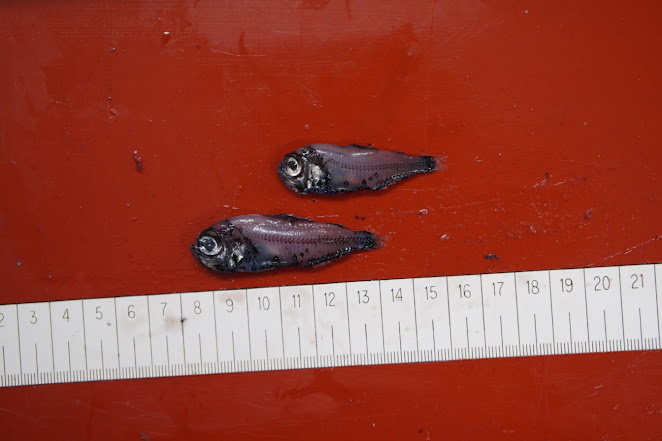Zaterdag 26 maart 2022 - Na trek 5 varen we verder naar het westen. In dieper water zien we geen blauwe wijting meer op het echogram. Het wordt een rustige dag. Om 14.23 UTC bereiken we het einde van het transect (53.19N-16.00W) en zetten koers naar het noorden. Om 16.57 UTC beginnen we aan het volgende transect op 53.46N-15.59W naar het oosten. Om 19:50 UTC op 53.46N-15.20W voeren we een miknet-trek (nr. 10) uit op 60m diepte. 'sNachts om 1:30 UTC komen we bij de noordwestelijke rand van de Porcupine Bank. Zoals verwacht verschijnt er een laag blauwe wijting op het echogram. Na wat technische problemen, zetten we om 2:30 UTC uit voor trek 6. De vangst bestaat uit blauwe wijting en meso-pelagische vis.
Saturday, March 26, 2022 - After haul 5 we sail further west. In deeper water we no longer see blue whiting on the echogram. It will be a quiet day. At 14.23 UTC we reach the end of the transect (53.19N-16.00W) and head north. At 16.57 UTC, we start on the next transect at 53.46N-15.59W to the east. At 19:50 UTC at 53.46N-15.20W we carry out a miknet tow (No. 10) at a depth of 60m. At night at 1:30 UTC we arrive at the northwestern edge of the Porcupine Bank. As expected, a layer of blue whiting appears on the echogram. After some technical difficulties, we shoot the net at 2:30 UTC for haul 6. The catch consists of blue whiting and mesopelagic fish.
 |
| Zonsopkomst met een paar Jan van Genten (Morus bassanus) op zaterdagochtend 26 maart. - Sunrise with a pair of Gannets (Morus bassanus) on Saturday morning March 26. |
 |
| Miknet-trek 10 wordt uitgezocht. - Mik net tow 10 is being sorted. |
 |
| Een grote petri-schaal met zeevlinders (Cymbulia peronii en Clio recurva) en - met gele tentakels - een siphonophore (Physophora hydrostatica). - A large petri dish with sea butterflies (Cymbulia peronii and Clio recurva) and - with yellow tentacles - a siphonophore (Physophora hydrostatica). |
 |
| Trek 6, 27 maart 53.46N-14.10W, 250kg blauwe wijting met ongeveer 10% meso-pelagische vis. - Haul 6, 27 Mar 53.46N-14.10W, 250kg blue whiting with about 10% mesopelagic fish. |
 |
| De vangst van trek 6 op de opvoerband. Tussen de blauwe wijting zit veel meso-pelagische vis en rood gekleurde garnalen. - The catch of haul 6 on the elevator belt. Among the blue whiting is a lot of meso-pelagic fish and red coloured shrimp. |
 |
| Een selectie van uitgesorteerde meso-pelagische vis uit de vangst van trek 6. - A selection of sorted meso-pelagic fish from the catch of haul 6. |






















Geen opmerkingen:
Een reactie posten